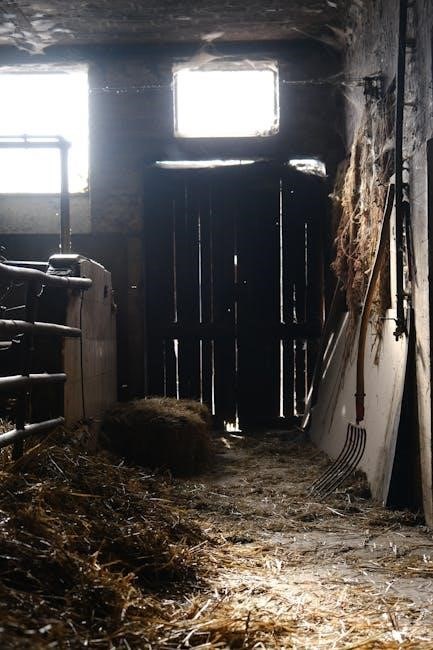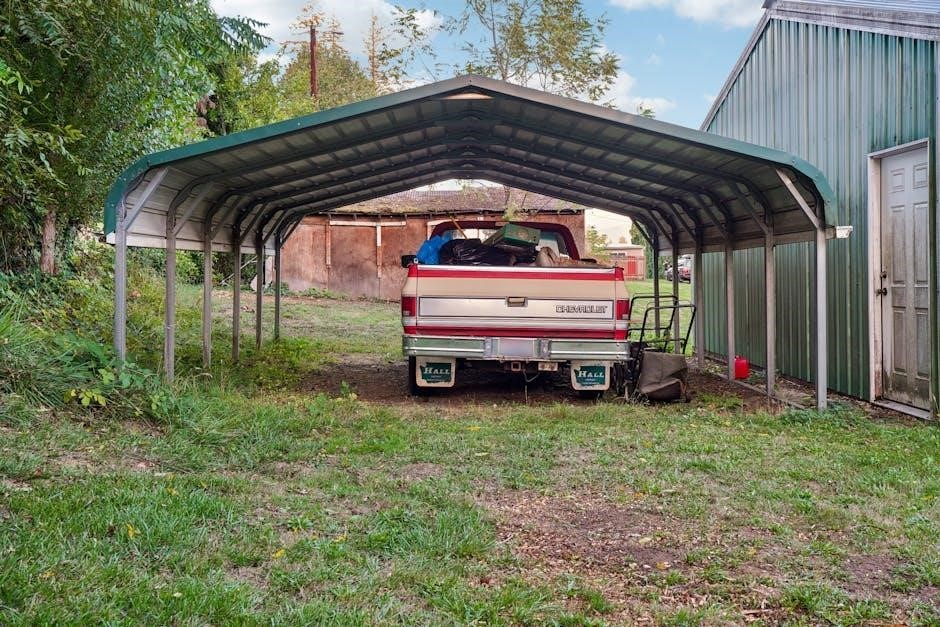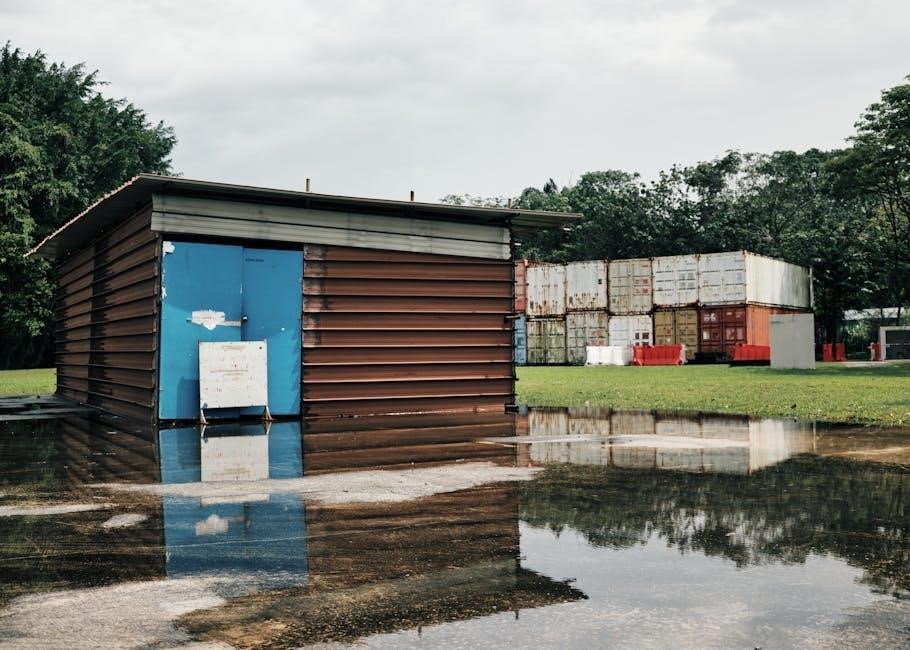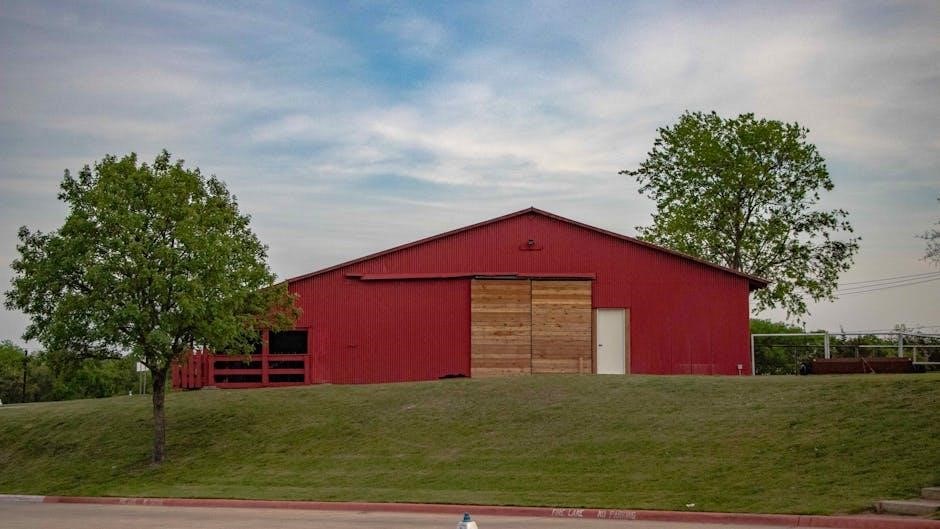The Rubbermaid 7×7 Storage Shed is a durable, weather-resistant resin building ideal for storing tools, lawn mowers, and outdoor equipment. Its compact design fits perfectly in small yards or gardens, offering ample storage space.

Following the assembly instructions ensures a secure and proper installation. The guide provides step-by-step directions, parts lists, and safety tips to help you build the shed efficiently and safely, maximizing its functionality and longevity.
1.1 Overview of the Rubbermaid 7×7 Storage Shed
The Rubbermaid 7×7 Storage Shed is a compact, durable, and weather-resistant outdoor storage solution designed to accommodate garden tools, lawn mowers, bikes, and pool supplies. Its 7×7 feet dimensions make it ideal for small yards or limited spaces while providing ample storage capacity. Constructed from high-quality resin, the shed is lightweight yet sturdy, ensuring long-lasting performance and minimal maintenance. The shed features a sturdy floor to support heavy items and is designed to withstand harsh weather conditions, including rain and UV exposure. Its sleek and modern design blends seamlessly with any backyard or garden aesthetic. The shed is easy to assemble, with clear step-by-step instructions provided to ensure a smooth installation process. Whether you need to organize your outdoor equipment or create a dedicated space for seasonal storage, the Rubbermaid 7×7 Storage Shed offers a practical and efficient solution. Its compact size and robust construction make it a versatile choice for homeowners seeking reliable storage options.
1.2 Importance of Following Assembly Instructions
Following the assembly instructions for the Rubbermaid 7×7 Storage Shed is crucial for ensuring a safe, secure, and functional installation. Proper assembly guarantees the shed’s structural integrity and prevents potential damage to the components. The instructions provide a clear, step-by-step guide, including diagrams of parts and hardware, to help you avoid mistakes. Safety precautions are emphasized throughout to protect you during the process. Neglecting the instructions may lead to improper alignment, instability, or exposure to weather, compromising the shed’s durability. Additionally, failing to follow the manual may void the warranty or lead to unsafe conditions. Taking the time to review and adhere to the instructions ensures a smooth assembly process and a shed that withstands harsh weather conditions. Always keep the instruction booklet and original receipt for future reference and customer support. By following the guidelines carefully, you can enjoy a sturdy, weather-resistant storage solution for years to come.

Pre-Assembly Steps
Before starting, review the parts list to ensure all components are included. Prepare the site by leveling the ground and clearing debris. These steps ensure a smooth assembly process and proper shed installation.
2.1 Checking the Parts List
Before assembling the Rubbermaid 7×7 storage shed, it’s essential to verify that all components are included in the package. Start by carefully unpacking and organizing the parts. Check for the floor panels, wall frames, roof sections, door components, hardware (like screws and bolts), and instruction manual. Compare each item with the provided parts list to ensure nothing is missing or damaged. This step prevents delays during assembly and ensures a smooth process. Organize the parts by category (e.g., floor, walls, roof) to make them easier to access later. If any parts are missing or damaged, contact the manufacturer immediately for replacements. Taking the time to inventory everything upfront saves time and frustration in the long run. A well-organized start sets the foundation for a successful assembly of your storage shed.
2.2 Site Preparation
Preparing the site for your Rubbermaid 7×7 storage shed is crucial for a successful assembly. Begin by selecting a flat, dry, and stable area in your yard, ensuring it is away from power lines, overhanging trees, and any drainage issues. Clear the site of debris, grass, or obstructions to create a clean workspace. Mark the area where the shed will be placed using stakes and twine to outline the 7×7-foot space. Ensure the location complies with local building codes and regulations. If necessary, consult with a professional to verify zoning requirements.
Next, lay down a weed barrier fabric to prevent plant growth underneath the shed, which could interfere with the foundation. If your shed will be placed on concrete or a patio, ensure the surface is clean and dry. For grass or dirt, level the ground slightly to ensure proper drainage. Finally, keep all the parts and tools within easy reach to streamline the assembly process. Proper site preparation ensures a stable base and makes the assembly process much easier and faster.
2.3 Leveling the Ground
Leveling the ground is a critical step to ensure your Rubbermaid 7×7 storage shed stands stable and secure. Begin by assessing the area you’ve prepared in the previous step. Use a shovel to dig slightly into the ground, creating a flat surface. A spirit level tool is essential for verifying that the ground is even. If the ground is uneven, remove or add soil as needed to achieve a level surface. Compact the soil firmly using a hand tamper or a heavy object to prevent settling after assembly.
For added stability, consider laying a layer of sand or gravel across the area. This not only helps with leveling but also improves drainage. Use a rake to spread the material evenly and check the level again. Once the ground is perfectly level, allow it to settle for a few hours before proceeding with the assembly. Proper leveling ensures the shed’s foundation is solid, preventing issues like water pooling or structural instability. Take your time with this step, as a well-prepared base is key to a successful assembly.

Floor Assembly

The floor assembly begins with attaching the floor panels together, ensuring all connections are secure. Use the provided hardware to tighten the panels firmly. Ensure the floor is evenly aligned and sturdy before proceeding to the next steps.
3.1 Step-by-Step Instructions for Floor Assembly
Begin by placing the floor frame on a flat, level surface. Attach the floor panels to the frame using the provided screws, ensuring they fit snugly into the pre-drilled holes. Tighten the screws firmly but avoid over-tightening. Next, connect the floor panels together by aligning the interlocking edges and securing them with the clips or bolts provided. Double-check the alignment to ensure the floor is even and sturdy. Once all panels are in place, verify that the floor is completely flat and secure. Use a rubber mallet to gently tap panels into position if necessary. Finally, ensure all hardware is tightened properly to prevent any movement or instability. Allow the floor to sit for a few minutes before proceeding to the wall assembly to ensure it has settled correctly.
3.2 Tips for Ensuring a Secure Floor
To ensure a secure and durable floor for your Rubbermaid 7×7 storage shed, start by double-checking that all panels are tightly fastened and evenly aligned. Use a level to confirm the floor is perfectly flat, as any unevenness can compromise stability. Apply weatherproof sealant to gaps between panels to protect against moisture damage. Additionally, secure the floor to the ground using anchor kits to prevent shifting in windy conditions. Tighten all connections firmly but avoid overtightening, which could damage the material. Regularly inspect the floor for signs of wear or loosening hardware and address issues promptly. For added stability, place heavy objects evenly across the floor to distribute weight. Finally, consider applying a protective coating to the floor surface to enhance durability and resistance to pests or mold. By following these tips, you can ensure your shed’s floor remains sturdy and secure for years to come.
Wall Assembly
Construct walls by attaching panels securely with provided hardware, ensuring proper alignment and stability. Verify each wall section is level and plumb, and all connections are tight. Cross-check alignment with the floor for a seamless fit.
4.1 Constructing the Walls

Begin wall assembly by organizing the wall panels and frames according to the manufacturer’s diagram. Ensure all components are labeled correctly and match the parts list. Start by attaching the side panels to the rear and front wall frames, using the provided screws and bolts. Make sure the corners are secure and the panels are tightly fitted together. Use a rubber mallet to gently tap pieces into place if necessary, avoiding force that might damage the material.

- Attach the wall panels to the floor frame, ensuring they align perfectly with the pre-drilled holes. Tighten the screws firmly but avoid overtightening, which could strip the threads.
- Repeat the process for the remaining wall sections, working systematically around the shed. Double-check that each panel is level and plumb before moving on to the next one.
- Once all walls are in place, inspect the connections to ensure stability and proper alignment. Address any gaps or misalignments immediately to maintain structural integrity.
Constructing the walls accurately sets the foundation for the rest of the assembly, so take your time and follow the instructions carefully.
4.2 Aligning and Securing Wall Panels
Once the wall frames are constructed, the next step is to align and secure the wall panels. Start by placing the panels into their respective frames, ensuring they fit snugly and align with the pre-drilled holes. Use clamps to hold the panels in place while you work, especially if assembling alone. Check the alignment using a spirit level to ensure the panels are straight and level.
- Begin at the bottom edge of the wall and work your way upward to prevent panels from shifting during assembly. Secure each panel with the provided screws, tightening them firmly but avoiding overtightening.
- Use shims or spacers if necessary to fill any gaps between panels and frames, ensuring a flush fit. Repeat this process for all wall panels, moving systematically around the shed.
- After securing all panels, inspect the walls for any misalignment or gaps. Make adjustments as needed to ensure the structure is stable and even.
Proper alignment and securement of wall panels are critical for the overall stability and durability of the shed. Take your time to ensure each panel is perfectly positioned and tightly fastened before proceeding to the next step.

Door Installation

Install the door by attaching the door frames to the wall assembly. Secure the hinges and hardware according to the instructions. Ensure the door aligns properly and swings smoothly. Double-check the latch mechanism for proper function.
- Use a level to confirm the door frame is straight.
- Tighten all screws firmly to avoid misalignment.
- Test the door’s opening and closing motion before finalizing.
5.1 Attaching the Door Frames
Begin by unpacking and organizing the door frame components. Locate the pre-drilled holes on the wall assembly where the door frames will attach. Align the door frame with the wall, ensuring it is level and properly positioned. Use the provided screws to secure the frame to the wall, tightening them firmly but avoiding overtightening. Double-check the alignment to ensure the door will swing smoothly once installed. Make sure the hinges are securely attached to both the door and the frame. If necessary, adjust the frame slightly to achieve proper alignment. Once the frame is in place, proceed to install the door itself, ensuring all hardware is included and correctly fitted. Always refer to the manufacturer’s instructions for specific screw locations and torque recommendations. Properly attaching the door frames is critical for the overall functionality and security of the storage shed. Take your time to ensure accuracy and stability during this step.
- Use a level to confirm the door frame is perfectly aligned.
- Check that all screws are tightened evenly to prevent warping.
- Ensure the hinges are properly seated and aligned before securing.
5.2 Installing the Door and Hardware
After securing the door frames, proceed to install the door panels. Carefully unpack and inspect the door components, including the hinges, latch, and locking mechanism. Attach the hinges to the door panels using the provided screws, ensuring they are aligned properly. Once the hinges are in place, mount them to the door frame, following the pre-drilled hole locations. Tighten the screws firmly but avoid overtightening, which could misalign the door. Next, install the latch and lock mechanism, ensuring it is securely fastened and functions smoothly. Test the door’s operation by opening and closing it several times to confirm proper alignment and smooth movement. Finally, attach any additional hardware, such as handles, to complete the installation. Always refer to the manufacturer’s guidelines for specific hardware placement and tightening torque. Proper installation of the door and hardware is essential for ensuring the shed’s security and ease of access.
- Use a screwdriver to tighten hinges and hardware securely.
- Double-check the alignment of the door and frame before final tightening.
- Test the door’s functionality immediately after installation.
Roof Assembly
The roof assembly involves placing the panels onto the frame, ensuring proper alignment with the walls. Secure the panels using the provided screws, starting from the center and working outward to maintain even pressure. Apply weatherproofing strips around edges for a watertight seal. Double-check all connections for stability and verify no gaps remain between panels. Follow the manufacturer’s guide for exact screw placement and tightening specifications. A securely fitted roof protects the shed from environmental damage and ensures durability.
Key steps: Align panels carefully, secure with screws, and seal edges properly.
6.1 Placing the Roof Panels
Begin by carefully lifting and positioning the first roof panel onto the top of the shed frame, ensuring it aligns with the pre-marked brackets. Gently lower the panel into place, making sure it fits snugly over the wall edges. Repeat this process for the remaining panels, working from the center outward to avoid bending or warping. Use the provided screws to secure each panel, tightening firmly but avoiding overtightening, which could damage the material. Check alignment frequently to ensure panels are evenly spaced and properly seated. Once all panels are in place, inspect the roof for any gaps or misalignments. Apply weatherproofing strips around the edges for a watertight seal. Finally, verify that the roof is level and securely attached to the walls before proceeding. Always follow the manufacturer’s instructions for exact placement and screw locations to ensure a sturdy and leak-free roof assembly.

Key considerations: Align panels carefully, secure with screws, and ensure a watertight seal.